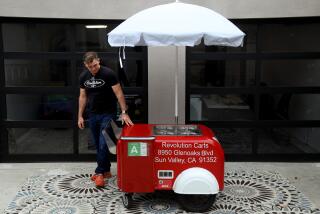The Venerable Shopping Cart Gets Souped Up
- Share via
CHICAGO — You may not have read about it in your high school history book, but more than 50 years ago an Oklahoma grocer named Sylvan Goldman changed the world.
The place was the Humpty Dumpty market in Oklahoma City. The year was 1937. The invention: the shopping cart. It gets better. Just listen.
“The shopping cart is a complex sociological phenomenon,” said Gene von Stein, vice president of Unarco Commercial Products, the nation’s shopping cart giant. “The shopping cart has totally changed the commerce and culture of America and the world.”
The jury may still be out on that, but the lowly cart does make the supermarket possible by giving shoppers a vehicle to purchase a week’s worth of groceries in a single trip.
In the past five years, this functional sculpture of wire on wheels has been the target of innovation--increasingly electronic, occasionally designed to assist the consumer, more often an effort to sell more products.
There are anti-theft gadgets and bolt-on baby seats, calculator/billboards and shopper tracking devices, carts for the kids and electronic tour guides. This week, they were all on display at the Food Marketing Institute’s supermarket convention in Chicago.
“I don’t know that shopping carts are going to get very space-age, but they’re functional and they get a little better all the time,” said Norman H. McMillan, a partner in the Chicago-based retail consulting firm McMillan/Dolittle.
Appropriately enough, Goldman’s pioneering pushcart was unveiled 53 years ago at the very first Supermarket Institute convention, the grandparent of FMI’s annual industry extravaganza.
Before the 1930s, mass general-merchandising stores were unknown and grocers gave their customers personal service. It was also a time when housewives shopped more often and bought fewer goods.
When that began to change, von Stein said, Goldman devised hand-carry baskets that he furnished to customers at his Humpty Dumpty markets in Oklahoma City and Tulsa.
“Then he saw that shoppers would stop shopping when they got the baskets full,” von Stein said. “The baskets were too heavy to carry. So he got the idea of putting the baskets on wheeled frames.”
By 1940, the company had developed the nesting shopping cart that can be found today in most grocery stores.
“The shopping cart has been the one piece of equipment essential to making self-service shopping a success,” von Stein said. “And all of modern consumer product merchandising is based on the concept of self-service.”
In February, 1988, Smart Products Inc. of Charlotte, N.C., sold its first bolt-on baby seat, a device that fits over the traditional child chair and lets parents fill a shopping cart with food, not children. The company has sold 20,000.
ADDvantage Marketing offers a calculator that fits over the handle of the cart. It allows consumers to tally their purchases so they can figure out what’s a better value: 16 ounces of detergent at $2.50 or 12 ounces at $1.75. It also has a mini-billboard with product advertising that stares up at shoppers for as long as they’re on the premises.
Information Resources Inc. of Chicago offers an interactive video screen that bolts onto cart handles and can tell shoppers where to find up to 800 items in the store. In addition, markets that use the product are fitted with infrared triggers that signal the VideOcart screen as the shopper moves through the store.
“As you go through the aisles, ads are triggered on the screen, or aisle specials, or promotional information on new products,” said Bill Dupre, a company spokesman.
Unarco unveiled its latest product this week, a gadget called Promotronics that fits on the end of the shopping cart and flashes advertising messages at consumers. It also records how long shoppers spend in the aisles and in front of certain products--valuable marketing information, von Stein said.
Some say, however, that shopping-cart innovation hasn’t gone far enough--that esoteric problems are being solved before basic components are perfected.
Or as McMillan put it: “If anyone could ever figure out how to get the wheels to turn round and round endlessly, that could be more valuable than all of this gadgetry.
THE CART THAT CHANGED THE WORLD
Birthdate: 1937
Inventor: Sylvan N. Goldman
Number sold each year: About 1 million
Major manufacturer: Unarco Commercial Products, Oklahoma City
Average price: $70-$120
Theft rate: The average food store loses about 12% a year.
More to Read
Inside the business of entertainment
The Wide Shot brings you news, analysis and insights on everything from streaming wars to production — and what it all means for the future.
You may occasionally receive promotional content from the Los Angeles Times.











